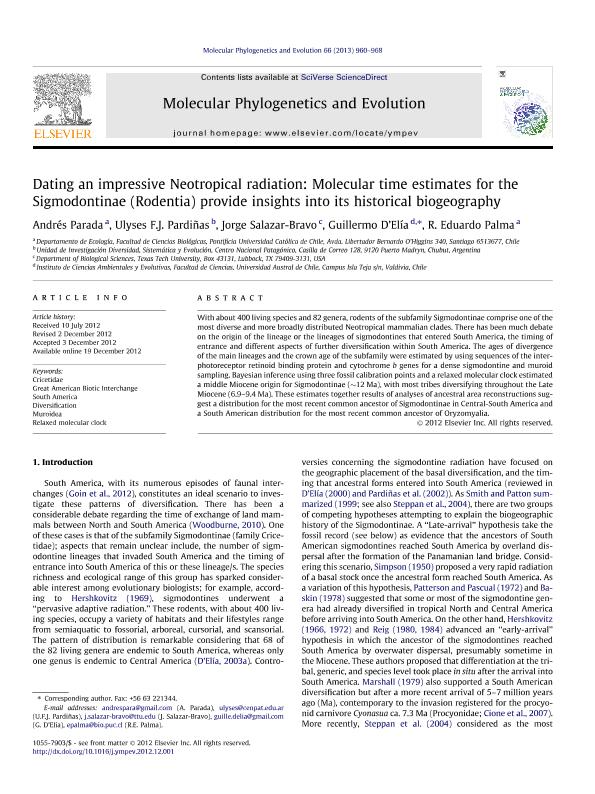Mostrar el registro sencillo del ítem
dc.contributor.author
Parada, Andrés
dc.contributor.author
Pardiñas, Ulyses Francisco J.

dc.contributor.author
Salazar Bravo, Jorge
dc.contributor.author
D'elía, Guillermo
dc.contributor.author
Palma, R. Eduardo
dc.date.available
2016-05-09T20:30:56Z
dc.date.issued
2013-01
dc.identifier.citation
Parada, Andrés; Pardiñas, Ulyses Francisco J.; Salazar Bravo, Jorge; D'elía, Guillermo; Palma, R. Eduardo; Dating an impressive Neotropical radiation: Molecular time estimates for the Sigmodontinae (Rodentia) provide insights into its historical biogeography; Elsevier; Molecular Phylogenetics and Evolution; 66; 3; 1-2013; 960-968
dc.identifier.issn
1055-7903
dc.identifier.uri
http://hdl.handle.net/11336/5595
dc.description.abstract
With about 400 living species and 82 genera, rodents of the subfamily Sigmodontinae comprise one of the most diverse and more broadly distributed Neotropical mammalian clades. There has been much debate on the origin of the lineage or the lineages of sigmodontines that entered South America, the timing of entrance and different aspects of further diversification within South America. The ages of divergence of the main lineages and the crown age of the subfamily were estimated by using sequences of the interphotoreceptor retinoid binding protein and cytochrome b genes for a dense sigmodontine and muroid sampling. Bayesian inference using three fossil calibration points and a relaxed molecular clock estimated a middle Miocene origin for Sigmodontinae (∼12 Ma), with most tribes diversifying throughout the Late Miocene (6.9–9.4 Ma). These estimates together results of analyses of ancestral area reconstructions suggest a distribution for the most recent common ancestor of Sigmodontinae in Central-South America and a South American distribution for the most recent common ancestor of Oryzomyalia.
dc.format
application/pdf
dc.language.iso
eng
dc.publisher
Elsevier

dc.rights
info:eu-repo/semantics/openAccess
dc.rights.uri
https://creativecommons.org/licenses/by-nc-nd/2.5/ar/
dc.subject
Cricetidae
dc.subject
Great American Biotic Interchange
dc.subject
South America
dc.subject
Diversification
dc.subject.classification
Zoología, Ornitología, Entomología, Etología

dc.subject.classification
Ciencias Biológicas

dc.subject.classification
CIENCIAS NATURALES Y EXACTAS

dc.title
Dating an impressive Neotropical radiation: Molecular time estimates for the Sigmodontinae (Rodentia) provide insights into its historical biogeography
dc.type
info:eu-repo/semantics/article
dc.type
info:ar-repo/semantics/artículo
dc.type
info:eu-repo/semantics/publishedVersion
dc.date.updated
2016-04-28T14:48:54Z
dc.journal.volume
66
dc.journal.number
3
dc.journal.pagination
960-968
dc.journal.pais
Países Bajos

dc.journal.ciudad
Amsterdam
dc.description.fil
Fil: Parada, Andrés. Universidad Católica de Chile; Chile
dc.description.fil
Fil: Pardiñas, Ulyses Francisco J.. Consejo Nacional de Investigaciones Científicas y Técnicas. Centro Nacional Patagónico; Argentina
dc.description.fil
Fil: Salazar Bravo, Jorge. Texas Tech University. Department of Biological Sciences; Estados Unidos
dc.description.fil
Fil: D'elía, Guillermo. Universidad Austral de Chile. Facultad de Ciencias. Instituto de Ciencias Ambientales y Evolutivas; Chile
dc.description.fil
Fil: Palma, R. Eduardo. Universidad Católica de Chile; Chile
dc.journal.title
Molecular Phylogenetics and Evolution

dc.relation.alternativeid
info:eu-repo/semantics/altIdentifier/url/http://www.sciencedirect.com/science/article/pii/S1055790312004794
dc.relation.alternativeid
info:eu-repo/semantics/altIdentifier/doi/10.1016/j.ympev.2012.12.001
dc.relation.alternativeid
info:eu-repo/semantics/altIdentifier/doi/http://dx.doi.org/10.1016/j.ympev.2012.12.001
Archivos asociados
